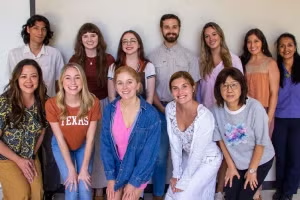A Salvadoran woman is promised a good job as a child care worker and ends up as a brothel worker or unpaid domestic servant.
An American child runs away from an abusive home and is prostituted for sex by a pimp.

A young Mexican man is brought across the border and forced to work in agriculture or in construction in the United States.
Slavery still happens.
In fact, human trafficking — selling people for sex and labor — has emerged as a major criminal and social justice issue in the United States and around the world, say University of Texas at Austin School of Social Work researchers.
“Human slavery is a robust, multi-billion dollar industry — only drugs and weapon dealing are more profitable,” said Dr. Noël Busch-Armendariz, associate professor of social work and director of the university’s Institute on Domestic Violence and Sexual Assault (IDVSA).
“Victims of trafficking have survived a horrifying combination of physical and emotional abuse, trauma and financial distress,” she said. “While much progress has been made in the fight against this hidden crime, there is room for improvement on many levels, including improving victim services and protections.”
Busch-Armendariz has led five studies on human trafficking since 2003, including recent research that explores types of traffickers. She also has testified twice before the Texas Legislature, most recently to support House Bill 4009, which called for a state-wide task force to combat human trafficking and passed in 2009.
In a study funded by two Texas agencies, the Office of the Attorney General and the Health and Human Services Commission, researchers evaluated the effectiveness of existing state human trafficking laws and social services for survivors. They interviewed victims, prosecutors, law enforcement investigators and service providers to make recommendations and address shortcomings.
The research became the basis for many policy and legislative responses to this crime.
“While scholarly debate continues regarding every aspect of trafficking, more attention needs to be paid to long-term services needed by victims and their families,” said Busch-Armendariz. “Valuable information regarding victims’ needs has been gathered in the past from service providers, but an understanding of those needs should be refined by victims themselves.”

Force, fraud, coercion and exploitation are generally agreed upon as the basics of what composes human trafficking.
Other characteristics and statistics include:
- U.S. citizens and foreign nationals are victimized by traffickers.
- According to the U.S. State Department, an estimated 600,000 to 800,000 people are trafficked across international borders each year, with 14,500 to 17,500 trafficked into the U.S.
- An estimated 200,000 American children are at high risk for trafficking into the sex industry each year.
- Of those trafficked internationally, 80 percent are female and 50 percent are children.
- In the U.S., the majority of foreign national trafficking victims are from Southeast Asia and Latin American countries. These victims end up in sex industries, domestic servitude, agricultural labor and sweatshops.
- The average age of a victim is 20 years old.
- Texas has more calls into the national human trafficking hotline than any other state.
Many believe that selling people for sex and labor has a broad global impact. It weakens legitimate economies, fuels violence, threatens public health and safety, and shatters families.
Research shows that victims are identified by traffickers because of their perceived vulnerabilities or lack of opportunities. Governments with unstable economies have populations that are particularly vulnerable, Busch-Armendariz said.

She believes more research is needed on topic, in particular the broader issues of global poverty, why and how people are lured into trafficking as victims and the strategies used by traffickers.
Those working to eliminate human trafficking continue to struggle with identifying victims, providing comprehensive and culturally competent services, appropriately addressing the needs of domestic survivors and securing the adequate resources and support, said Laurie Cook Heffron, project manager of the studies.
Victims face tremendous fears and trauma, for which they need immediate and ongoing emotional support, say the researchers. Among these concerns are continued harm towards themselves or their families inflicted by the traffickers, uncertainty about the future and financial survival, health concerns, family reunification issues and unresolved immigration status.
The Central Texas Coalition Against Human Trafficking, composed of social service and law enforcement organizations, is one group designed to address these issues. Busch-Armendariz, Heffron and other members of the IDVSA staff have been members of the coalition since its inception.
“In the beginning, I felt scared to move around on my own, and the caseworkers would go everywhere with me. Little by little I got to know places and started to lose the fear. I began to want to explore a little bit on my own.” — Human trafficking survivor
“They need to know that not every person they come into contact with is about to victimize them,” said Busch-Armendariz. “That kind of assurance needs to be there at a really basic level.”
While many governments around the world are addressing the issue of human trafficking, the United States and Texas may be leading the way toward a better understanding of the issue through implementation of effective criminal justice and social service responses, Heffron said.
The attention paid to trafficking in the 1990s led to legislation to protect victims and increase prosecution. President Bill Clinton signed the Trafficking Victims Protection Act in 2000 and there have been subsequent reauthorization acts setting domestic and international standards for anti-trafficking efforts, including prevention, prosecution of traffickers and protection of victims.
“It’s a bipartisan issue,” said Busch-Armendariz. “Everyone wants to get these bad guys.”
She includes the topic of human trafficking in her classes, making the work, Busch-Armendariz believes, a perfect fit with the university’s mission and core purpose of teaching, research and public service.
“I never realized how big an issue it was until I took this course with Dr. Busch-Armendariz,” said Gloria So, who is working on her master’s degree in social work.
As part of the course, she was able to work with a local anti-trafficking organization on a special public service announcement campaign.
“Putting my knowledge into practice to address the social justice issues of human trafficking was really important for me as a social work graduate student,” said So. “I was able to integrate theory and information with practice to make a difference in my community.”
Because the needs of trafficking victims are often extensive, few social service agencies exist whose sole mission is to help its victims, said Heffron. The service needs are met by a variety of agencies.
Collaborative partners often include refugee settlement providers, domestic violence providers, immigration attorneys, victim assistance providers, resettlement providers, heath services providers, social workers and local and federal governments.
Many study participants expressed a desire to be financially independent and not rely on support from community organizations or government assistance. One survivor was starting her own business and was making significant steps toward generating income.
Short-term goals of human trafficking survivors include finding a better job with better hours and pay, becoming independent of social services and other public support, obtaining a high school degree, reunifying with children and becoming proficient in English.

“If I am always dependent on someone else, I will never progress. I think that here in this country, one of the things you need to survive is to have courage, be brave in order to do what you have to do.” — Human trafficking survivor
Long-range goals include remaining in the U.S., sending children to college, owning a home, starting a small business and working with other victims.
The last goal — summoning the capacity, the confidence and the strength to give back to others who’ve experienced similar trauma and exploitation — is pretty remarkable and a true indication of “survivorhood,” said Busch-Armendariz.
“The people who work in this field — the social workers, human service professionals, law enforcement and prosecutors and those making policies to address and eradicate this crime — are equally remarkable,” said Busch-Armendariz. “I’ve never seen a more committed group of individuals. They are working together to end modern-day slavery.”



